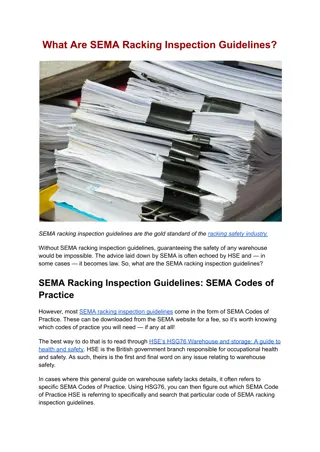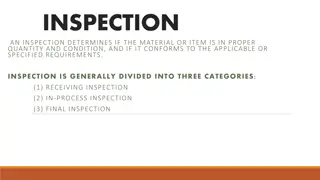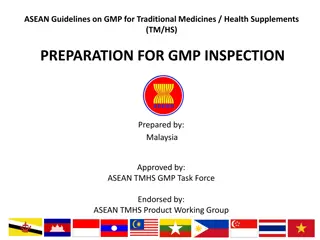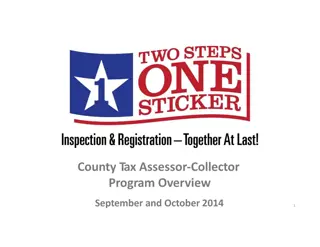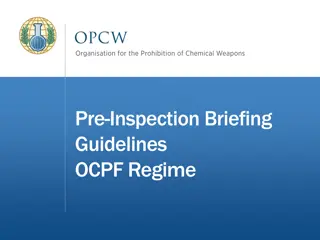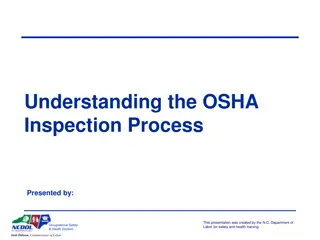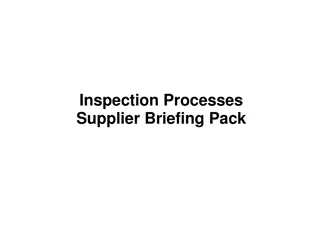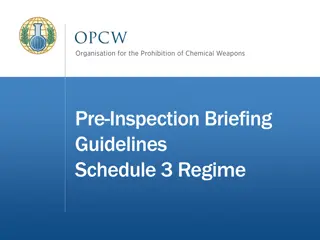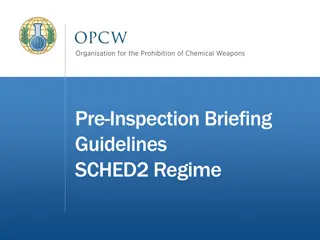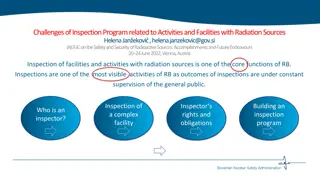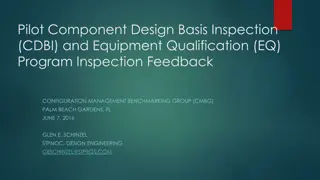Comprehensive Guidance on First Article Inspection (FAI) Process
This detailed guide covers the activities involved in the First Article Inspection (FAI) process, outlining responsibilities across various functions such as scheduling, training, documentation, and resource planning. It emphasizes the importance of multidisciplinary collaboration, resource allocation, and competency of personnel to ensure successful FAI execution and on-time delivery of conforming parts. Common issues and solutions are also addressed to enhance FAI planning effectiveness.
Download Presentation

Please find below an Image/Link to download the presentation.
The content on the website is provided AS IS for your information and personal use only. It may not be sold, licensed, or shared on other websites without obtaining consent from the author.If you encounter any issues during the download, it is possible that the publisher has removed the file from their server.
You are allowed to download the files provided on this website for personal or commercial use, subject to the condition that they are used lawfully. All files are the property of their respective owners.
The content on the website is provided AS IS for your information and personal use only. It may not be sold, licensed, or shared on other websites without obtaining consent from the author.
E N D
Presentation Transcript
1 Define the activities to be performed throughout the FAI process and identify the responsible organizations for those activities Requirements Background AS9102B 4.2b: FAI planning shall address the activities to be performed throughout the FAI process and identify the responsible organizations for those activities. First Article Inspection (FAI) is a verb. The FAI process involves actions from multiple functions to be coordinated in order to meet all requirements in support of on-time delivery of conforming parts. Successful FAI planning will identify and ensure clarity of the responsibilities for each individual contributing to the FAI process, such as: FAI scheduling, resource availability, performance and effectiveness metrics FAI training applicable to each affected organization Design characteristic accountability, including DPD extraction FAI inspection plan creation Gauge and tooling selection External sources (e.g. qualified sources, special processing, raw material suppliers) Documentation collection Determination of objective evidence to support attribute acceptance FAIR creation, evaluation and approval Change review and identification of changes requiring an updated FAI Next Steps Example / Opportunity 1. FAI planning process should be executed by a multidisciplinary team to ensure coordination of all affected organizations (engineering, quality, purchasing, operations, etc.) 2. Ensure that all FAI processes are defined for each affected function prior to production start: FAI is a basic element of new program and/or product Quality Plan 3. Use of verifications tools (checklists, software) is highly recommended to avoid omission of the activities to be performed during the FAI process Common issues of deficient FAI planning process are: Failure to document FAI forms prior to first delivery, resulting in deliver delay Omission of design characteristics from FAI forms Resulting in product nonconformance and/or NOE Missing inspection results and/or product records needed to complete FAI forms
2 Ensure adequate resources are provided to complete FAI activities on the first production delivery parts and meet on-time delivery Requirements Background AS9102B 4.1a: The organization shall perform FAI on new product representative of the first production run. The first production delivery parts require an FAI Organizations must plan for the cross functional accomplishment of activities involved in both planning for and executing First Article Inspection processes. Failure to identify the necessary activities or resources in advance of production can result in poor quality or bottlenecks affecting on-time delivery of products. AS9100D 8.1c: determining the resources needed to achieve conformity to the product and service requirements and to meet on-time delivery of products FAI resource planning and monitoring can identify bottlenecks early to allocate more resources to accomplish necessary tasks, such as: Production and inspection equipment and personnel availability Inspection planning Collection and verification of required quality records FAI training for all affected personnel FAIR creation, evaluation and approval Next Steps Example / Opportunity 1. Define scheduling of all FAI activities required to meet on-time delivery 2. Define resources needed to complete FAI activities to meet on-time delivery 3. Establish metrics to ensure FAI activities are accomplished on time Inspection planning FAI form creation Collection of necessary quality records Completion and approval of FAI forms 4. Ensure leadership understands that there are no provisions to defer FAI Common issues when adequate resources are not properly planned: Inspection plans are not created to account for all design characteristics Design characteristics are not recorded during FAI In-process inspections are missed FAI forms are not created before production begins Production or inspection equipment is not available to support FAI Personnel are not trained to perform FAI activities properly FAI forms contain errors due to rushed work Necessary records are not available to support completion of FAI forms
3 Ensure competency of all personnel performing First Article Inspection activities Requirements Background AS9100D 8.5.1e: The organization shall implement production under controlled conditions, including the appointment of competent persons [with] any required qualification; AS9100D 7.2: The organization shall: a. determine the necessary competence of person(s) doing work under its control that affects the performance and effectiveness of the quality management system; b. ensure that these persons are competent on the basis of appropriate education, training, or experience; c. where applicable, take actions to acquire the necessary competence, and evaluate the effectiveness of the actions taken; d. retain appropriate documented information as evidence of competence. FAI planning and execution processes require personnel who understand their role in the FAI processes and have demonstrated competency to meet requirements. The skills needed to extract engineering requirements, create inspection plans, measure products and complete FAI forms differ and must be performed by appropriate personnel. Competency refers to the ability to apply knowledge and skills to achieve intended results (ISO9000 3.10.4). A person is competent when two conditions are both satisfied: (1) the person has acquired the required knowledge and skills; (2) the person is able to apply the acquired knowledge and skills on the work they are doing to ensure intended results can be achieved. Competency should be determined on basis of education, training and experience. Next Steps Example / Opportunity 1. Determine the competence of persons performing FAI activities, from all affected departments or disciplines. 2. Take actions to address any competency gaps identified. 3. Evaluate effectiveness of actions taken: Determine measures and criteria for effectiveness evaluation. When determining measures, consider use of combination of theoretical examination, practical examination, performance evaluation, management review and job observation. When FAI forms are found to be incomplete or completed incorrectly, it is important to understand why. The organization should assess whether the different FAI activities were performed by appropriate personnel. For example, if it is found that implicit dimension measurement results have been omitted from the FAI forms there are several possible causes to consider: Did the person completing the FAI forms know to record implicit characteristics? Were all necessary inspection results recorded in the QMS? Were inspection plans prepared to collect necessary implicit characteristics? Were implicit characteristics extracted from DPD properly? Each of the above activities require different knowledge and skills and it should not be assumed that everyone is capable of performing all activities.
4 Define QMS health measures to ensure continued effectiveness of FAI planning and performance Requirements Background AS9100D 4.4.1: The organization shall determine the processes needed for the QMS and their application throughout the organization, and shall: c. determine and apply the criteria and methods (including monitoring, measurements and related performance indicators) needed to ensure the effective operation and control of these processes; AS9100D 7.5.1b: The organization s QMS shall include documented information determined by the organization as being necessary for the effectiveness of the QMS AS9100D 5.1.1a: Top management shall demonstrate leadership and commitment with respect to the QMS by taking accountability for the effectiveness of the QMS AS9100D 9.3.2: The management review shall be planned and carried out taking into consideration information on the performance and effectiveness of the quality management system, including trends in: 1. customer satisfaction and feedback from relevant interested parties; 2. the extent to which quality objectives have been met; 3. process performance and conformity of products and services; 4. nonconformities and corrective actions; 5. monitoring and measurement results; 8. on-time delivery performance; Appropriate measures will help ensure adequate resources are engaged at the appropriate stages to ensure all necessary FAI activities are completed in a timely manner to support on-time delivery. Effectiveness measurement of each step will help ensure process health. Some of the critical steps in the FAI process are: Extraction of requirements from engineering design Verification of build instructions and tooling to ensure part conformance Collection of inspection data to complete FAI reports Completion of FAI forms Evaluation and approval of FAI forms Ongoing evaluation of manufacturing and engineering changes All production nonconformances should be evaluated to understand if the nonconcormance should have been detected during FAI and, when applicable, what steps(s) in the FAI process failed. Next Steps Example / Opportunity 1. Identify which key QMS processes require process performance metrics 2. Set up a metrics review and cadence 3. Ensure accountability for each function when process performance is less than acceptable 4. Ensure management communication of QMS Health within the organization that provides both context and meaningful data Consequences of unhealthy FAI planning and performance can include: Late deliveries Delivery of nonconforming parts and Notifications of Escape Accumulation of FAI reports Not Complete Failure to evaluate production changes affecting product conformance
5 Determine design characteristic inspection methods, sequencing and recording of results to support FAI Requirements Background AS9102B 4.5h:The organization shall verify the design characteristics that are the output of the manufacturing process are measured, inspected, tested, or verified to determine conformance, including DPD characteristics. AS9102B 4.7.3: The organization shall record the requirements and results in the units specified on the drawing, DPD, or specification. AS9100D 9.1.1:The organization shall determine: a. what needs to be monitored and measured; b. the methods for monitoring, measurement, analysis, and evaluation needed to ensure valid results; c. when the monitoring and measuring shall be performed. D6-51991N 7.1: When product definition include digitally defined surfaces/features (3D models), the supplier must ensure inspection of these surfaces/features FAI requires independent inspection to verify that production processes and tooling produce products that meet design requirements. Selecting the correct measurement device and approach involves: Assessing suitability of measuring devices Assessing procedures and operators Assessing any measurement interactions Calculating measurement uncertainty Recording inspection results in the units specified in design Production tooling that has not been independently validated and approved to be used as a media of inspection cannot be used to verify products created by the same production tool. Next Steps Example / Opportunity 1. Ensure use of robust inspection plans 2. Use Measurement System Analysis (MSA) when appropriate 3. Use D950-11207-1 Boeing document for Gauges for Verification and Acceptance A Selection and User's Guide for Production, Field, and MRO Environments. 4. Ensure competency of personnel recording results in the units specified in the design engineering documents (such as, DWG, PL, Specifications, DPD etc.). 5. Ensure a robust calibration system Common FAI noncompliances include: Recording 9102 form 3 Results with attribute data (e.g. Accept or Pass ) when design requirements are defined with variable units Measurement with inappropriate devices and/or methods Inadequate resolution (e.g. using calipers to measure close tolerance) Accepting part per tool Failure to define FAI inspection method Failure to measure design characteristics and/or record results Leaving measurement device selection to inspector Inspection plans do not clearly illustrate inspection operations
6 Verify all design characteristics will be accounted for throughout the manufacturing process Requirements Background AS9102B 4.5g:Verify that every design characteristic requirement is accounted for, uniquely identified, and has inspection results traceable to each unique identifier. Escapes occur when organizations fail to verify design characteristics during FAI. It is important that the FAI process includes verification that all design requirements are accounted for and recorded in the FAI report. FAI must account for all design characteristics defined on the drawing. Common causes for missing drawing requirements include: FAI Requirements derived from production planning, instead of engineering design. FAI report limited to production operations without ensuring all design requirements accounted for. FAI measurements limited to production tooling. Next Steps Example / Opportunity 1. Use a requirement consumption validation process to verify every design characteristic has been accounted for. Requirement consumption should be performed by Engineering and verified by Quality. 2. Ensure each design characteristic requirement is uniquely identified and recorded on the FAI report (ballooning software can be used to eliminate human errors). Every design characteristic requirement is accounted for, uniquely identified, and has inspection results traceable to each unique identifier Inspection results NOT traceable to each unique identifier
7 Extract DPD design characteristics both implicit and explicit (when utilizing Model Based Definition engineering) not fully defined within 2D drawings Requirements Background D6-51991N 7.6: First Article Inspection: All explicit and implicit design characteristics within the engineering shall be positively identified within the FAI plan. This shall include all engineering characteristics requiring traceability: a) All features annotated within the 3D model (explicit) b) Features of the 3D model not annotated (implicit) D6-51991N 7.3: Suppliers who receive reduced content drawings with an associated 3D model, must be able to extract information from the 3D model sufficient for manufacturing and inspection in addition to the 2D drawing. D6-51991N 7.3.1: Suppliers must identify and document for manufacturing and inspection, the following requirements at a minimum. a) All features identified on the 2D drawing b) Features of the 3D model not defined by the 2D drawing AS9102B 4.2.c.2: Extraction of DPD design characteristics required for product AS9102B 4.3: Digital Product Definition Requirements Every design characteristic must be recorded on the FAI Report (FAIR). To do so may require extraction of implicit characteristics from 3D models and reduced content 2D drawings. Failure to extract design characteristics will lead to an incomplete and ineffective FAI process. This creates risk that the production process has not been verified adequately to ensure it is able to produce products that meet requirements. Next Steps Example / Opportunity 1. 2. Ensure personnel are aware of implicit and explicit design characteristics Verify processes exists to extract design characteristics not annotated on the 3D model or reduced content 2D Drawing, with the applicable tolerance Plan for and identify a unique characteristic number which will trace the design characteristic within the FAIR Record all implicit and explicit design characteristics in a controlled inspection plan for each product When implicit characteristics are omitted from the FAI report, it is important to understand why. Causes for omitting implicit data from FAIR can include: Person completing FAIR failed to record implicit data Implicit characteristic was not included in the inspection plan 3. 4.
8 Determine need for and suitability of any designed tooling or qualified tooling to be used for product verification Requirements Background AS9100D 7.1.5.1: The organization shall determine and provide the resources needed to ensure valid and reliable results when monitoring or measuring is used to verify the conformity of products and services to requirements. The organization shall ensure that the resources provided: a. are suitable for the specific type of monitoring and measurement activities being undertaken; b. are maintained to ensure their continuing fitness for their purpose. The organization shall retain appropriate documented information as evidence of fitness for purpose of the monitoring and measurement resources Specially designed or qualified tooling is never an afterthought and must be identified as a necessary resource during the FAI planning phase. When a qualified tool is used to provide an attribute result for a variable requirement, the tool must be within the appropriate nominal ranges and tolerances of the feature being measured. When a specially designed tool is utilized, the calibration and maintenance of this tool must be pre-planned and the results of the measurement must be in a format suitable to meet the requirements of AS9102 (ref. 4.7.3b and Form 3 field 10). AS9102B 4.7.3:Record Results AS9102 Form 3, field 10: Designed / Qualified Tooling: Next Steps Example / Opportunity 1. Develop or purchase the necessary tooling to ensure that every design characteristic can be properly accounted for during FAI 2. Ensure that processes for developing or selecting suitable designed tooling or qualified tooling assess: Tool suitability to measure the affected design characteristic(s) Tool use instructions Tool maintenance to ensure continuing fitness for use Common issues when designed or qualified tooling is not planned for properly: Design characteristics are not measured GD&T features not measured properly Attribute results are recorded when variable results are required
9 Ensure use of customer approved sources and materials, when required Requirements Background AS9100D 8.4.1:The organization shall ensure, when required, that customer- designated or approved external providers, including process sources (e.g., special processes), are used. AS9102B 4.5: The organization shall conduct the following activities during product realization, when applicable, in support of FAI to ensure conformance with design characteristics: d. Verify that required customer approved sources are utilized. Aerospace designs and production controls can require use of approved sources for materials, parts and processes. Failure to use approved sources can result in product nonconformances, disruption to Boeing and its customers and damage the reputation of Boeing and its suppliers. Every producer must understand the requirements to use approved sources, flow these requirements to their suppliers and ensure that everyone is using up to date approval information. Next Steps Example / Opportunity 1. Verify that affected personnel understand how to use D1-4426 to ensure special processes are performed by approved sources http://active.boeing.com/doingbiz/d14426/index.cfm 2. Ensure that internal organizations and sub-tier suppliers understand how to use, and have access to, current Qualified Producer Lists (QPL) 3. Verify that purchase contracts include requirements to use approved sources when applicable (e.g., special processes, designated fasteners, raw materials) 4. Ensure receiving inspection processes verify that received materials or processes meet customer requirements, including certifications with the correct addresses and content, as applicable MANUFACTURER'S PRODUCT DESIGNATION AM 2755-B Manufacturer s address on Certificate of Conformance does not match QPL manufacturer address MATERIAL CLASSIFICATION Type 1 Class B MANUFACTURER Aero Materials, Inc 6789 Industrial Way Seattle, WA 98124
10 Ensure manufacturing planning and purchase documents call out the correct specifications and sources Requirements Background AS9102B 4.5: The organization shall conduct the following activities during product realization, when applicable, in support of FAI to ensure conformance with design characteristics: a. Review documentation for the manufacturing process (e.g., routing sheets, manufacturing or quality plans, manufacturing work instructions) to ensure all operations are complete as planned and call out the correct specification, material types, conditions, and approvals. c. Verify that the raw material and special process certifications call out the correct specification, material types, conditions, and approvals. d. Verify that required customer approved sources are utilized. Manufacturing planning errors can create product non-conformances by calling out incorrect materials or processes, or by omission of critical information, such as material or process: type, class, condition, length, width, thickness or color. Procurement must ensure that all necessary material or process definition is included in purchasing documentation and that only approved sources are used when required. Receiving Inspection must ensure that that all necessary material or process definition is included in supplier s certificate of conformance and that materials and processes are provided by approved sources. Properly performed FAI will verify that the manufacturing planning and procurement documents call out the correct and complete material and process definitions, and ensure they are received from approved sources. Example / Opportunity Next Steps 1. Ensure that your organization has processes to verify manufacturing plans and associated procurement documents reflect drawing requirements accurately 2. Verify that material callouts include all necessary information, including material or process: classification: grade, type, form, thickness or color 3. When outside sources are utilized, ensure that sources have the necessary approvals If the manufacturing planning is used as the source of requirements to be recorded on the FAI, that practice does not meet the requirements of AS9102 and can result in escapes not being detected. Past investigations of supplier escapes have revealed manufacturing planning and the associated FAI calling out an incorrect material. Personnel performing FAI must be diligent verifying that requirements are defined in product design. FAI is a good opportunity for Quality to review and confirm that all manufacturing planning complies with design requirements.
11 Identify and document in-process inspection/verification results necessary to demonstrate the conformity of products to their requirements, including requirements defined within process, material and finish specifications required for product realization Requirements Background AS9100D 8.1:The organization shall plan, implement, and control the processes needed to meet requirements for the provision of products, and to implement the actions by: b2. establishing criteria for the acceptance of products and services; e2. determining, maintaining, and retaining documented information to the extent necessary to demonstrate the conformity of products to their requirements; AS9100D 8.5.1:The organization shall implement production and service provision under controlled conditions. Controlled conditions shall include, as applicable: m. the identification of in-process inspection/verification points when adequate verification of conformity cannot be performed at later stages; n. the availability of evidence that all production and inspection/verification operations have been completed as planned, or as otherwise documented and authorized The collection of inspection results requires planning in advance: what to inspect; when inspection is to occur; how the inspection is to be performed and recorded; and by whom. In order to effectively verify each production process. AS9102 requires accounting for every characteristic on the drawing or DPD. This includes recording all process, material and finish requirements called out on the drawing or DPD. When process, material and finish requirements are recorded on the FAIR with qualitative Results (e.g. Pass or Accept) the FAI process should also include verification of documented evidence that all embedded requirements have been met, as required by AS9100D 8.1, to the extent necessary to demonstrate the conformity of products to their requirements. Next Steps Example / Opportunity 1. Review the production processes to see if adequate in-process inspection/verification points are identified; pay special attention to processes that adequate verification of conformity cannot be (economically) performed at later stages. 2. Identify in-process inspection/verification points, including the method and sequence of inspection/verification. 3. Determine the requirements for documented information to be retained. Mature organizations pre-plan FAI inspections/verifications with callouts documented in the manufacturing plans, supported by inspection plans and pre-populated FAI forms that contain all design requirements. These preparation activities will: Standardize inspection processes Ensure all characteristics are accounted for Collect and verify necessary supporting data Improve visibility of needed improvements Reduce confusion, re-inspections and other production disruptions prior to deliveries
12 Determine objective evidence to be included with FAI Report for each design characteristic, including process, material and finish specification requirements Requirements Background AS9100D 8.1e2: The organization shall plan, implement, and control the processes needed to determine, maintain, and retain documented information to the extent necessary to demonstrate the conformity of products to requirements. Every design characteristic on the drawing/DPD must accounted for on the FAIR with results recorded in the units specified on the drawing/DPD, unless otherwise approved by the customer. When variable data is not required and attribute inspection results are recorded, the organization must determine, maintain, and retain documented information to the extent necessary to demonstrate the conformity of products to requirements. AS9102B 4.2.c.3: Determination of objective evidence to be included in the FAIR for each design characteristic. When tooling is used as a media of inspection, the tool must be approved to measure the affected characteristic with sufficient supporting documentation to demonstrate conformity. When attribute results are recorded on the FAIR, supporting records must exist and be verified to the extent necessary to demonstrate conformity of products to requirements, including embedded requirements of process, material and finish specifications. Example / Opportunity Next Steps 1. Ensure processes exist to determine, maintain, and retain documented information to the extent necessary to demonstrate the conformity of products to all applicable requirements, such as: Recording variable data directly on FAIR with unique characteristic number Recording attribute results on the FAIR that is supported by documented evidence of conformity to all requirements (e.g. tool design and inspection records, process control audit results, material records) 2. Ensure that supporting records demonstrate the conformity of products to all applicable requirements. 3. Ensure that applicable supporting records are verified during FAI and retained as required. The producer must identify all embedded requirements of process, material and finish specifications applicable to product and must determine how to record evidence of conformance. It is recommended to assign unique characteristic numbers on the FAIR to select characteristics from specifications. These specification characteristics should be chosen based on established risk assessment tools and recorded in the units specified in the specification. Regardless of whether a specification characteristic result is recorded on the FAIR with variable data or attribute results, the producer must retain documented objective evidence to demonstrate conformity to all applicable requirements.
13 Evaluate the need to perform a full FAI or a partial FAI in the event of changes that invalidate the original results (e.g., engineering changes, production process changes, tooling changes see AS9102 4.6). This process must include documented information describing the results of the review of changes, the person(s) authorizing the change, and the decision to perform a full FAI or a partial FAI Requirements Background AS9100D 8.5.1.3: The organization shall use a representative item from the first production run of a new part or assembly to verify that the production processes, production documentation, and tooling are able to produce parts and assemblies that meet requirements. This activity shall be repeated when changes occur that invalidate the original results (e.g., engineering changes, production process changes, tooling changes). AS9100D 8.5.6:The organization shall review and control changes for production to the extent necessary to ensure continuing conformity with requirements. Persons authorized to approve production changes shall be identified. The organization shall retain documented information describing the results of the review of changes, the person(s) authorizing the change, and actions arising from the review. AS9102B 4.6f:The organization shall perform a full FAI or a partial FAI for affected characteristics, when any of the following occurs: 1. A change in the design characteristics affecting fit, form, or function of the part. 2. A change in manufacturing source(s), process(es), inspection method(s), location of manufacture, tooling, or materials that can potentially affect fit, form, or function. 3. A change in numerical control program or translation to another media that can potentially affect fit, form, or function. Next Steps FAI is a process to validate that product realization processes are capable of producing parts and assemblies that meet engineering design requirements. Changes in engineering, production process or tooling may alter those production realization processes. As changes can lead to risks, we must have effective change management processes in conjunction with a robust verification process such as FAI. Change management processes must document evaluation of all changes for the need to perform FAI, including: Engineering changes Manufacturing process changes Tooling changes NC programming changes Inspection method changes While AS9102 requires recording partial or re-accomplishment of FAI, AS9100 goes further and requires review and control of all changes. Even when a change evaluation results in determination that a partial or re-accomplishment of FAI is not required, the Example / Opportunity 1. Review existing change management process to identify possible gaps: The change management process should integrate with FAI process The change management process should involve all concerned departments 2. Evaluate product escapes to determine if the escape was the result of a change that was not subject to partial or re-accomplishment of FAI. Investigations have revealed improperly controlled changes to be the cause of escapes. If your organization has experienced escapes as the result of changes not subject to partial or re-accomplishment of FAI, you need to reevaluate your change control processes.
14 Ensure timely corrective actions are implemented to complete FAI Requirements Background AS9100D 10.2.1:When a nonconformity occurs, including any arising from complaints, the organization shall: a1. take action to control and correct it; h. take specific actions when timely and effective corrective actions are not achieved. When FAI is applicable, all products must eventually have FAI Complete status. As long as the FAI remains Not Complete the production process remains unproven to be able to produce conforming product, creates risk to the production system and extra controls need to be in place to mitigate those risks until the FAI is Complete. Time to implement corrective actions can be dependent on the complexity of actions required (planning changes, process changes, sub-tier corrective actions, tooling changes, equipment changes, material changes, engineering/design changes). Nevertheless, the organization must take specific actions when timely and effective corrective actions are not achieved. AS9102B 4.4c: The organization shall implement corrective action(s) and perform a partial FAI for all affected characteristics on the next production run, after implementation of the associated corrective action(s). If the partial FAI does not clear all identified nonconformances, the FAI is still not complete and the requirement to complete the FAI is still in effect. Next Steps Example / Opportunity Define processes to ensure timely and effective corrective actions are achieved to Complete all FAIs. 1. Monitor the quantity and age of all FAIs with Not Complete status 2. Take specific actions when effective corrective actions are not achieved to Complete FAIs in a timely manner 3. Document risk mitigation plans for all parts with FAIs Not Complete 4. Perform partial FAI after implementation of corrective action 5. Engage design engineering if the FAI remains Not Complete after corrective actions have been taken When FAI records remain Not Complete for extended periods of time, the organization should be evaluating the effectiveness of their corrective action processes. If after exhausting all viable improvements to the processes, equipment, tools, measurement equipment, materials, personnel, etc., the organization determines the process is still not capable of producing conforming product, engineering changes to the design should be pursued. When multiple corrective actions are required that are implemented over time, partial FAIs should be performed incrementally to ensure the effectiveness of the actions taken and reduce risk.



